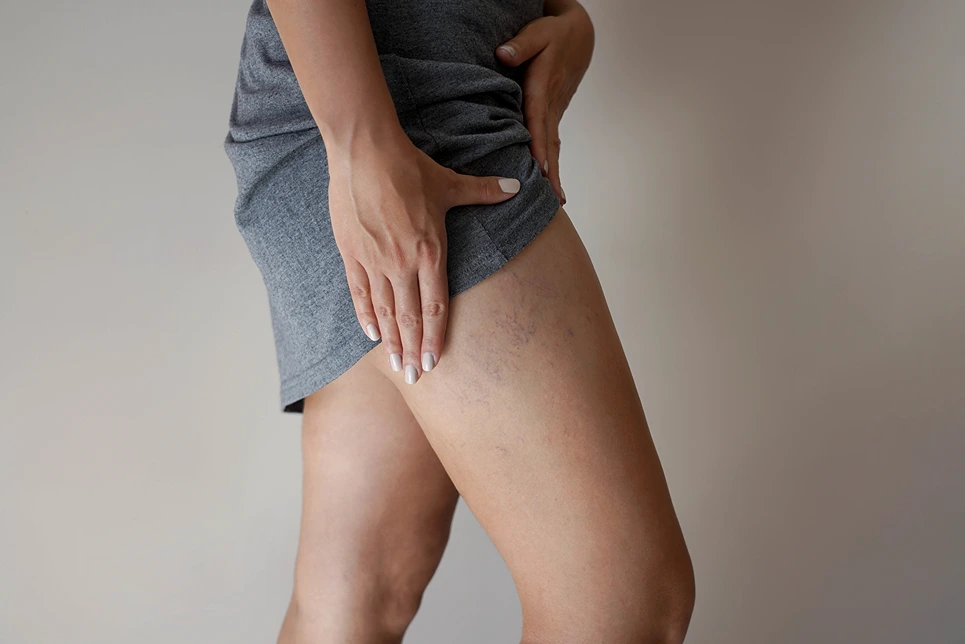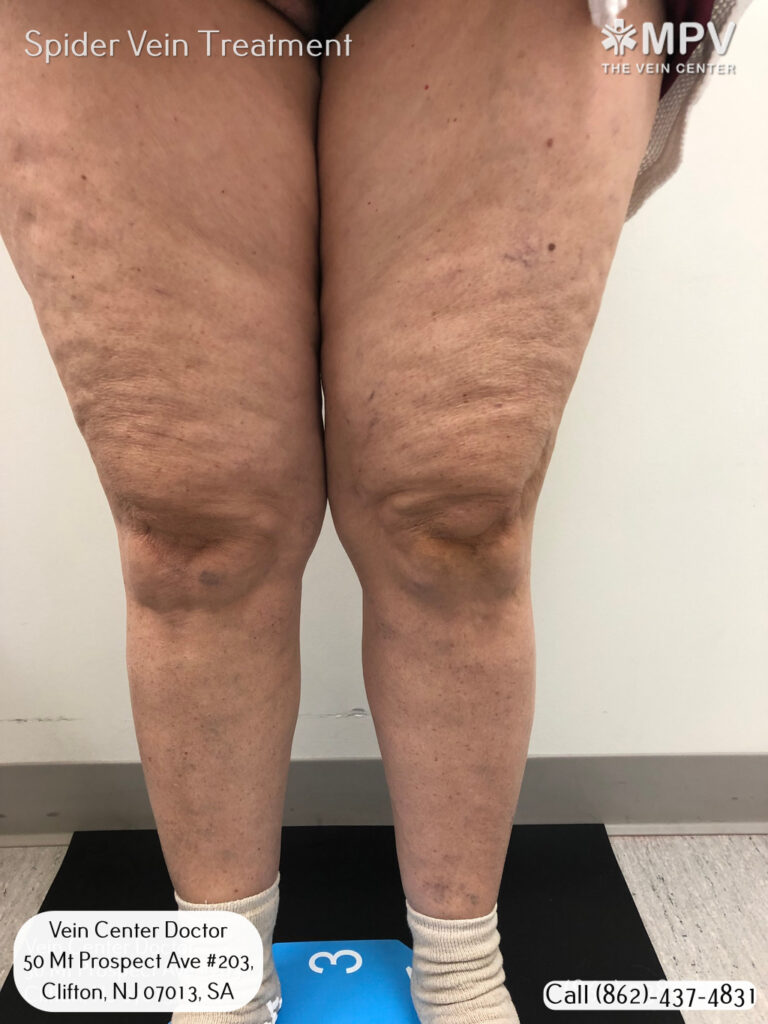Are embarrassing spider veins increasingly visible on your legs when you stand? You're not alone - over half of American women will experience spider veins at some point in their lives.
Living with unwanted veins is a thing of the past, when you can simply schedule a free consultation with Vein Center Doctor and find your ideal solution today.
Spider veins, medically known as telangiectasias, are very fine, threadlike broken blood vessels that sometimes appear near the surface of the skin.
They look like tiny red, blue or purple lines or webs, typically 1-3mm in diameter. Spider veins are different from varicose veins, which are larger, rope-like veins that bulge near the surface of the skin.
While they may be unsightly, spider veins themselves usually do not affect a person's health. They form when small vessels near the skin's surface enlarge and branching reddish patterns become visible. Factors like genetics, prolonged standing, age, weight gain/loss, pregnancy and menstrual cycles contribute to fragile valves in the veins weakening over time.
There are a few key factors that contribute to the development of spider veins:
Genetics: Those with a family history of varicose veins or other circulatory issues are more genetically predisposed.
Gravity & prolonged standing: Long periods of standing put increased hydrostatic pressure on leg veins, stretching fragile vessel walls and weakening valves over time.
Weight gain/loss: Significant weight fluctuations place strain on veins and abdominal wall support structures.
Pregnancy: The growing uterus compresses major leg veins during pregnancy, raising risk as valves may not regain full function postpartum.
Exercise: High impact exercises like jogging without proper compression can worsen existing weak veins.
Menstrual cycles can cause spider veins to become more prominent, but they do not cause spider veins to form.
Age: Elasticity of vein walls lessens naturally with age, impacting valve function.
Skin injury: Past burns, wounds or ulcers in the legs can damage vein integrity.
Genetics predispose some, but lifestyle habits are also important factors in spider vein development for many. Addressing preventable triggers may help one stay spider vein-free longer.
Spider veins tend to show up more prominently when standing because of increased hydrostatic pressure in the legs. When one is standing upright, gravity exerts more pressure on the veins, causing more blood to pool in the lower legs.
This builds up pressure within the veins, stretching and enlarging them slightly. In folks predisposed to fragile valves, it can also cause the valves to leak or fail, letting blood flow backward and widen the veins. Sitting or lying down decreases this gravitational pressure, so the veins are less noticeable. Compression stockings help counter this increased pressure when standing to lessen spider vein visibility.
While genetic traits and inevitable effects of aging make some risk of spider veins unavoidable, there are lifestyle steps one can take to potentially help delay or lessen their appearance:
Wearing compression stockings or socks during the day helps counter gravity's effects on veins by boosting circulation back up the legs.
Of course, prevention is not foolproof as genetics highly influence one's risk too. But these lifestyle habits may potentially delay or lessen severity of spider vein formation for some.
The main differences between spider veins and varicose veins are their size and appearances:
| Aspect | Spider Veins | Varicose Veins |
| Size | Smaller, measuring 1-3mm in diameter | Much larger, measuring 3mm or more in diameter |
| Appearance | Finer, threadlike or web-like in reddish or bluish hues | Bolder, ropelike or serpentine with twisted or knotted bulges |
| Arrangement | Often appear in clusters or networks | Typically branch out singularly from larger main veins |
| Symptoms | Usually mildly uncomfortable or asymptomatic | Can lead to throbbing, aching, or heaviness, worsened by activity |
| Depth | Skin deep | Go deeper into muscle layers under the skin |
If you see clusters of thin threads or webs, it's likely spider veins. A single large bulging rope-like vein is more characteristic of varicose veins. Consulting a dermatologist can provide the most accurate assessment.
Here are some natural options that may help fade the appearance of spider veins over time:
1. Apply witch hazel with a cotton ball or pad daily. Its astringent properties can constrict vessels and reduce redness.
2. Massage legs daily using essential oils that are high in antioxidants. Try frankincense, cypress or juniper diluted in a carrier oil. Gently knead from feet to hips.
3. Drink more water and stay well hydrated to improve blood viscosity and circulation. Dehydration can strain the body's ability to flush waste.
4. Elevate legs daily for 15 minutes. Use pillows under calves to encourage drainage away from delicate veins.
5. Regular leg exercises strengthen muscles that assist returning blood back to the heart. Try stretches or using an exercise bike or elliptical.
6. Topical natural anti-oxidants like grape seed, pine bark or green tea extracts may tighten fragile vessel walls over weeks with consistent application.
Having realistic expectations is key, as natural remedies alone may only mildly lessen visibility at first. But paired with a healthy lifestyle, some see noticeable improvement after consistent months of holistic self-care. Consulting your physician ensures any concerns are properly monitored too.

If you have visible spider veins and want to cover them for a special occasion, here are some options to considered:
| Steps | Details |
| Apply a skin-toned concealer made for legs and feet. Rub gently until veins disappear. Set with loose translucent powder. | Concealer for legs and feet can help hide veins. Finish with translucent powder to set the makeup. |
| Look for color-correcting primers, gels, or creams designed to neutralize the tones of spider veins before makeup. | Use specialized makeup products to neutralize the appearance of spider veins before applying makeup. |
| Try medicated stockings/sleeves claimed to temporarily constrict veins from view. Wear snugly under clothing. | Explore medicated options to temporarily reduce the visibility of veins under clothing. |
| For low-cut dresses, apply concealer then fix a nude color pantyhose, tights, or leggings in place to fully cover legs. | Conceal and cover your legs when wearing low-cut dresses by using concealer and nude-colored legwear. |
| Dark, patterned hosiery or knee-high socks can draw the eye away from any underlying veins showing at hemlines. | Opt for dark, patterned hosiery or knee-high socks to divert attention from visible veins at hemlines. |
| Consider a spray tan a few days prior. The veil of color may partially mask some finer veins. | A spray tan can provide a subtle cover-up for finer veins by adding a veil of color to your skin. |
| Cold leg massages before the event may lessen vein dilation and make them less noticeable. | Massaging your legs with cold water before an event can help reduce vein dilation and their visibility. |
With the right techniques and products, you can comfortably enjoy special events veil-free. Camera flash may still pick them up though.
In most cases, spider veins themselves are not medically dangerous and considered primarily a cosmetic concern. However, it's important to note:
Larger varicose veins deeper in tissues can pose a higher risk for more serious conditions if left untreated, like deep vein thrombosis or stasis dermatitis.
Spider veins on the face are treated more urgently to avoid potential discoloration or skin damage from picking/scratching at them.
Those with a genetic hyper-clotting disorder may face a higher thrombosis risk if veins are inflamed or actively bleeding.
Severe cases with clustering may cause symptoms like aching, fatigue, itching or skin changes over time.
So while small spider veins alone tend not to impact health seriously, it's always best to consult your doctor to assess severity, check for risk factors, discuss treatment options, and ensure any concerns seen are benign in nature. Realizing whether they present negligible versus higher risk is worthwhile.
The number of treatments needed to successfully remove spider veins can vary depending on the individual and severity of the case. However, here are some general guidelines:
It's common for 60-80% of veins to vanish after the initial session, with successive treatments eliminating remaining residuals. Full clearance could take 6 months, though vast improvement is often seen sooner. Staying consistent with coverage and follow up advances long term outcomes.
Individual results may vary, so discussing your specific veins' size, depth and concentration helps determine an ideal treatment plan. Most are very pleased with 3-5 spaced sessions.
When it comes to effectively removing spider veins, laser therapy has become a leading nonsurgical treatment option for its precision and fast recovery.
Lasers work by targeting the hemoglobin in blood inside veins, generating heat to collapse and seal vessels. This allows the body to naturally absorb remaining fragments over weeks. Most see 70-80% clearance after the initial session, with high satisfaction from 2-5 treatments depending on case severity.
Sclerotherapy involves injections of a saline solution to inflame and seal off vein walls from within. It takes more sessions to thoroughly treat larger vascular areas and has a slightly higher risk of side effects like staining. Recurrence can also be higher without proper compression therapy adherence post-procedure.
For resilient cases, combining sclerotherapy with laser treatment may optimize outcomes. Other emerging options like radiofrequency ablation are also promising minimally-invasive approaches. Overall, lasers remain a leading preference for most spider vein sufferers seeking effective removal along with an expedited recovery process and natural cosmetic results. But each case requires customized evaluation and counsel from an experienced clinician.

Spider veins tend to run in families, so a genetic influence and predisposition is common. Having a parent or multiple relatives with similar vein issues increases one's likelihood.
However, their eventual formation still requires environmental triggers to take effect over time, like pregnancy, weight fluctuations or prolonged standing episodes.
While post-treatment recurrence is possible depending on underlying risk factors and lifestyle habits, properly done laser or sclerotherapy procedures offer long-lasting outcomes for most patients.
Maintaining a healthy weight, regular leg exercises, and wearing proper compression hosiery during activity days can help prevent regrowth long-term. For those genetically prone, clusters may redevelop slowly in other areas years later as valves weaken further with age. But prompt retreatment targeting any recidivism usually controls this process successfully.
Overall patient satisfaction remains high, given initial investments' lasting vein-fading effects. Open discussion with your specialist can customize the ideal long-term maintenance plan for your unique spider veins case and genetics.
Find exactly what you need to get rid of your vein-related problems. Dr. Sood and the rest of our team at Vein Center Doctor are ready to help: schedule your free consultation today.
Most Insurance is accepted for treatment